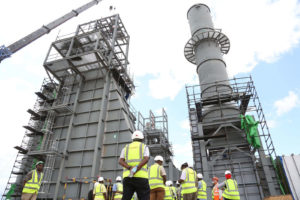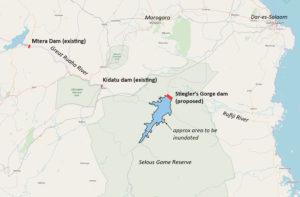by Roger Nellist
Good news in the electricity sector

Dkt. Tito E. Mwinuka and other Tanesco officials view progress on the Kinyerezi II power plant in Dar-es-Salaam.
In early April President Magufuli inaugurated a major new electricity generating plant known as Kinyerezi II in Dar es Salaam. Deploying six turbines, the plant will eventually add an additional 240 MW (megawatts) of electricity to the national grid. The President said that 1,513 MW is currently being produced in Tanzania, which falls well short of the country’s needs. Noting that about 60% of Tanzanians still do not have any electricity and that hundreds of thousands of hectares of forests are being cut down for firewood and charcoal instead, the President called for a tripling of the country’s present electricity generating capacity so that the government’s goal of attaining middle-income status by 2025 can be fulfilled. “A reliable power supply is crucial for the country’s economic growth since it enables manufacturers to produce continuously, hence creating more employment,” he explained. He also called on TANESCO to find ways to reduce power tariffs, to benefit consumers and industries.
Kinyerezi II was constructed by the Japanese company Sumitomo and cost just over $350 million to build. Japanese soft loans financed 85% of that cost whilst Tanzania funded the remaining 15%. The project was completed more than a month ahead of schedule and employed some 2,000 workers during its construction, 80% of whom were Tanzanian.
The recently appointed Minister for Energy, Dr Medard Kalemani, who joined the President at the inauguration, gave details of the other big power projects that will be implemented over the next five years. Together, they will help fulfil the President’s goal of tripling Tanzania’s electricity generating capacity. Those projects are: Kinyerezi III, which will add a further 600 MW, and Kinyerezi IV at least another 330 MW.
Moreover, work on the controversial hydropower generating project at Stiegler’s Gorge is set to begin in July this year and will take 36 months to complete. The huge project – which has been on the cards since the 1970s when ambitious plans were first drawn up – involves the construction of a dam on the Rufiji River in the Selous Game Reserve, set to be the largest dam in Tanzania. The Stiegler’s Gorge plant is designed to generate 2,100 MW – sufficient to put an end to the electricity outages and shortages that have beset the country for so long and possibly provide some surplus for export to neighbouring countries.
The Minister said that the government is currently providing the essential infrastructure to service the Stiegler’s Gorge project’s construction: “We are now connecting the area with electricity from Morogoro … We are also building roads to connect the area … It is our hope that the project will be completed by early 2021”. The project itself awaits final approvals.
Acacia Mining
Following last year’s mega dispute with the government over the exports of gold concentrates and the amount of tax underpaid, Acacia Mining (Tanzania’s largest gold producer) released a financial statement in mid-April announcing that its gold production fell 45% in the first quarter of 2018 compared with a year earlier. Its production of 121,000 ounces was due to lower output at its main Bulyanhulu mine (which has faced reduced operations since last autumn) and because of lower grade ore at its Buzwagi mine. Its first quarter revenues were down accordingly by 33%.
The company said it is currently studying the best ways to restore full-scale operations at its Bulyanhulu gold mine, which it expects to do by 2020. It also clarified that although gold mining will cease at Buzwagi later this year the mine will not be closed but for the next two or three years will process stockpiles of its gold ores.
Also in mid-April, Acacia Mining’s human rights record in Tanzania came under renewed scrutiny and criticism when five Tanzanian and international human rights groups issued a press release and sent an open letter to Acacia’s Board of Directors urging them to step in to improve the company’s human rights record at its North Mara Gold Mine. They expressed alarm that Acacia’s new community grievance mechanism to address long-standing human rights and other complaints at the mine fell well short of the company’s human rights obligations.
Since 2014 numerous reports have drawn attention to serious violations at the North Mara Mine, including killings, beatings and sexual violence. Last September the International Commission of Jurists said it was “deeply concerned about the gravity of many of [the] allegations and the difficulties [victims] experienced in accessing any adequate remedy and reparation”. Subsequently, Acacia revamped its community grievance mechanism at North Mara, providing a process whereby victims can bring human rights and other complaints to mine officials for investigation, compensation and remedy. However, although some progress has been made in addressing some victims’ claims, the rights group consider the revised mechanism to fall well short of what is required. They maintain it is not compliant with the United Nations Guiding Principles on Business and Human Rights, and “lacks human rights benchmarks, lacks transparency, lacks independence, provides very limited legal assistance for an overly legalistic process, and creates confusion about whether it will accept complaints about police abuse at the mine site, among other problems”. Tanzania’s Legal and Human Rights Centre recently stated that “Tanzanians deserve to have their rights respected by multinational companies conducting business in our country … . Acacia Mining and [its parent company] Barrick Gold should … ensure the North Mara community grievance mechanism is independent, fair and transparent”.


Pingback: Tanzanian Affairs » GOVERNMENT DEFENDS STIEGLER’S GORGE DAM PROJECT